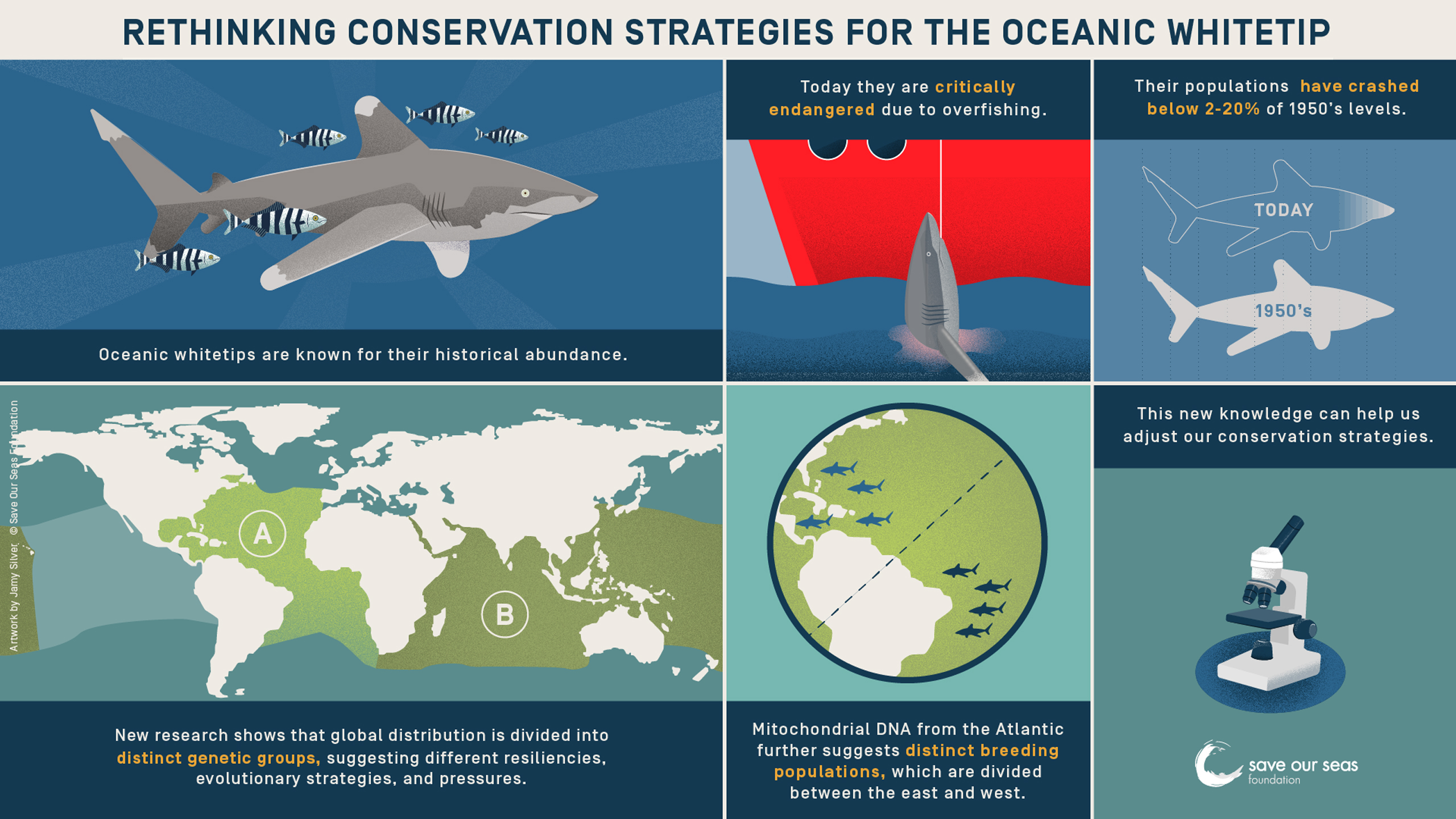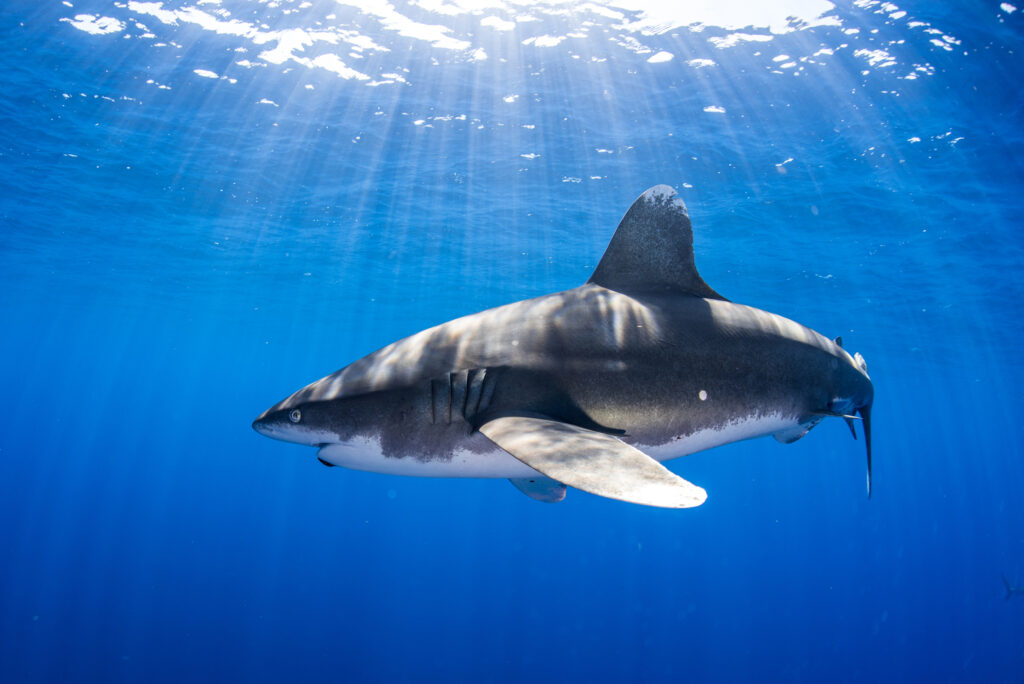The oceans between us
There are oceans between us: genetics uncover structure and diversity in wide-ranging but imperilled oceanic whitetip shark populations
Imagine a shark that was once so plentiful that it found infamy among torpedoed war-time sailors and downed pilots. And now visualise that same shark as one of the ocean’s rarest; a Critically Endangered species whose global population has crashed by 98% since the 1950s. Scientists are scrambling to save the oceanic whitetip shark, an important open-ocean predator whose nomadic ways have kept us in the dark about its real population structure and genetic diversity. But a new scientific paper, ‘Cross ocean-basin population genetic dynamics in a pelagic top predator of high conservation concern, the oceanic whitetip shark, Carcharhinus longimanus’, was published in the journal Conservation Genetics this month. And it turns what we thought about the passport-defying ways of big, mobile sharks on its head.
‘This is the first global-scale view of the genetics of this species and the first to use nuclear markers to assess population and genetic diversity,’ says Professor Mahmood Shivji, director of the Save Our Seas Foundation Shark Research Center (SOSF-SRC) and Guy Harvey Research Institute, Nova Southeastern University. Professor Shivji and his team have discovered that oceanic whitetips do not occur in a single genetically homogenous population that moves across the planet’s oceans and in which individuals interbreed. Instead, oceanic whitetip sharks in the Atlantic Ocean are genetically distinct from oceanic whitetip sharks in the Indo-Pacific region.

Artwork © Jamy Silver | Save Our Seas Foundation
The team’s study is the first to investigate the worldwide connectivity and genetic diversity of the species. The finding that there are two global genetic populations comes from using both nuclear (inherited from both parents) and mitochondrial (inherited from the mother only) genetic markers. ‘So we know that at least two clearly different populations exist in this species, indicating that they are largely genetically isolated from each other, even though they can swim long distances and theoretically interbreed – but in practice they don’t,’ explains Professor Shivji.
Researchers recently conducted the first study to investigate the worldwide connectivity and genetic diversity of oceanic whitetip sharks. Photo © Christopher Vaughan-Jones
A population in peril
Resilience is a requirement for the oceanic whitetip shark. Like an underwater Memphis Belle B-52 bomber, it moves through the deep waters offshore using its iconic white-tipped, paddle-shaped pectoral fins and dorsal fin. In fact, it is these very fins that have got the ‘Lord of the Long Arms’ (as Jacques Cousteau famously dubbed this shark) into trouble. The species is taken as bycatch in many purse-seine, pelagic longline and gill-net fisheries that target tuna. It is also specifically caught for its fins, which are valued in the international shark-fin trade, while its meat, liver oil and skin are harvested too.
Considered a top predator that prefers the upper water column (from the surface to a depth of about 200 metres; 650 feet) in offshore tropical and subtropical oceans worldwide, the oceanic whitetip shark is undoubtedly an important piece of a complex ecological puzzle. Based on calculations that the species has declined by more than 80% over three generations (oceanic whitetip sharks are estimated to live for up to 25 years, so that’s since around the 1950s), the International Union for the Conservation of Nature (IUCN) has categorised this species as Critically Endangered on its Red List of Threatened Species.
They got it from their mothers?
Together with Cassandra Ruck (lead author on the paper and former graduate student at the SOSF-SRC), Rima Jabado and Andrea Bernard, Professor Shivji found significant differences in both the nuclear and the mitochondrial DNA of oceanic whitetip sharks from the Atlantic and Indo-Pacific oceans. The nuclear DNA differences help to tell us that, although these large-bodied, wide-ranging sharks in theory can move across the oceans and interbreed, in practice they don’t.
‘Even though each species originated in one place in the marine realm,’ explains Professor Shivji, ‘many shark species subsequently spread from their place of origin to colonise other oceans. Examples are tiger, oceanic whitetip, blue, white and shortfin mako sharks, as well as great hammerheads.’ Indeed, the team at the SOSF-SRC previously published its findings that tiger sharks, although widely distributed and capable of making incredible ocean-scale journeys, have developed genetically distinct subpopulations in the Atlantic and Indo-Pacific oceans. ‘Since they spread out,’ continues Professor Shivji, ‘there have been changes in ocean currents and temperature, and in the animals’ behaviour, that have prevented the globally spread-out individuals within a species from continuing to mix and interbreed. And so they have evolved into genetically different populations.’
But the mitochondrial DNA adds even more nuance to the discovery, because this form of DNA can only be inherited through the maternal line and therefore tells us something about where these sharks are born. ‘There are at least two clear matrilineal genetic populations within the Atlantic Ocean: the eastern Atlantic and western Atlantic,’ explains Professor Shivji. There is, the scientists say, potentially evidence of even more matrilineal populations within the western Atlantic, but this needs to be confirmed with additional samples and markers.
The idea is that a behaviour known as natal philopatry by females (where female sharks reliably return to their birthplace to give birth to their own pups) and ocean temperatures and currents, as well as other biological factors such as the availability of prey and the distribution of different essential shark habitats, have all acted as natural barriers to interbreeding on a broad geographic scale. As a result, shark populations within ocean basins have been genetically divided further.
Professor Shivji and his team have discovered that oceanic whitetip sharks in the Atlantic Ocean are genetically distinct from oceanic whitetip sharks in the Indo-Pacific region. Photo © Christopher Vaughan-Jones
(Micro)management: why genetics helps us change the way we manage sharks
It had been the predominant school of thought that large-bodied, wide-ranging sharks can and do move freely across our oceans, mixing and breeding – and their populations tend to have been managed as such. But we now know that although the oceans seem borderless to us, these three-dimensional environments offer all manner of differences that allow sharks to choose where they associate (or act as natural barriers to the sharks’ movement). Fisheries management can now, for instance, consider the genetic distinctiveness of the Atlantic and Indo-Pacific populations of the oceanic whitetip shark. ‘Genetically different populations first need to be identified,’ elaborates Professor Shivji, ‘so that management strategies can be refined to conserve each genetically unique population.’ It is vital to tailor strategies to each population when a species is Critically Endangered and considered under urgent threat.
But there is some good news, it seems, for oceanic whitetip sharks. There is no doubt that they are in big trouble, but the scientists were also able to show that this species has medium to high levels of genetic diversity. This will stand it in good stead as the climate changes and seas become increasingly polluted, diseased and fragmented. ‘This is good news,’ says Professor Shivji, ‘because many other species that have experienced rapid, large reductions in their numbers have often also shown a large decline in their genetic diversity.’ If suitable conservation measures are implemented quickly and effectively, the scientists say, this genetic diversity may allow oceanic whitetip sharks to adapt and stay resilient as the oceans change.
And the changes affecting the oceans are rapid: overfishing, variations in sea surface temperatures and ocean chemistry, and the loss of coastal habitats all operate on timescales that outstrip the pace at which many species can adapt. Knowing how populations are structured genetically helps us to understand what their relative resilience might be in the face of change. A small, genetically isolated population must be managed very differently from one that is broadly distributed around the world and across different habitats. The more we know about sharks, the better we are able to refine our own behaviour, policies and management interventions to accommodate their particular challenges. If our understanding of the oceanic whitetip shark had remained that its populations are similar wherever they are found, we might have stood to lose its true diversity and undermined its resilience in the face of grave threats.

Knowing how populations are structured genetically helps us to understand what their relative resilience might be in the face of change. A small, genetically isolated population must be managed very differently from one that is broadly distributed around the world and across different habitats. Photo © Christopher Vaughan-Jones
*** References:
Cross ocean‐basin population genetic dynamics in a pelagic top predator of high conservation concern, the oceanic whitetip shark, Carcharhinus longimanus. Conservation Genetics . https://link.springer.com/article/10.1007/s10592-023-01596-1
Cassandra L. Ruck, Mahmood S. Shivji, Rima W. Jabado, Andrea M. Bernard
